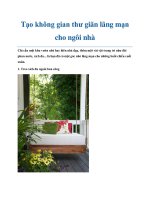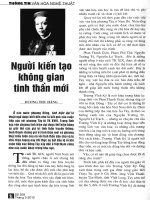Creating Your Own Drawing Space - Tạo không gian Vẽ riêng của bạn
Bạn đang xem bản rút gọn của tài liệu. Xem và tải ngay bản đầy đủ của tài liệu tại đây (270.13 KB, 5 trang )
CREATING YOUR
OWN
Brenda Hoddinott
A-04 GETTING STARTED: With the increased popularity of home based computers, a
renaissance of classical drawing endeavors, and a resurgence of art-based businesses, comes an
exciting and virtually limitless choice of options for furnishing an in-home art studio.
In this 4-page article, I offer numerous suggestions for setting up your own in-home studio or
expanding your current workspace, as well as ideas for planning and packing a portable studio
for taking your art outdoors or traveling. The following topics are discussed:
CHOOSING A STUDIO SPACE
SHEDDING LIGHT ON YOUR ART
CHOOSING A DRAWING SURFACE
SELECTING STUDIO FURNISHINGS
PUTTING TOGETHER A PORTABLE STUDIO
This article is recommended for artists of all ages and abilities, as well as home
schooling, academic and recreational fine art educators.
Published by Hoddinott Fine Art Publishers, Halifax, NS, Canada – Revised 2005
Copyright to all articles, images, text, projects, lessons and exercises within this drawing class belong to Brenda Hoddinott and
may not be reproduced or used for any commercial purposes whatsoever without the written permission of Brenda Hoddinott.
Web site or
2
CHOOSING A STUDIO SPACE
With the onset of home based computers, a renaissance of classical drawing endeavors, and a
resurgence of art-based businesses, came an exciting and virtually limitless choice of options for
furnishing a home art studio.
With a little innovative thought, you can easily find some sort of space in your home for your
creative activities. When you consider potential locations for your studio, take your surroundings
into account, such as its proximity to your computer, phone, and windows. Your special artistic
place should also be peaceful and free of distractions.
Consider the following three options:
A CREATIVE CORNER: You can easily turn an unused corner of any room into a drawing
space. If friends or family use the same space, compromises, careful planning, and respect
are critical. Choose a drawing time that provides minimum inconvenience for others.
SETTING UP A SMALL STUDIO SPACE: If you are blessed with a room of your own, it
will be even easier to create a small personal studio in a corner of this room.
TRANSFORMING A ROOM INTO AN ART STUDIO: With a serious commitment to
drawing, and ample space in your home, comes an opportunity to set up a fully equipped art
room. An in-home studio provides privacy and a very special personal space you can design
and tailor to suit your needs.
Be creative! You will enjoy customizing a drawing space to meet your individual needs. Make it
a place in which you will enjoy spending time. Look through some decorating books and
magazines for potential options for customizing your very own drawing space. Visit some
furniture, stationery, art supply, business, and department stores.
SHEDDING LIGHT ON YOUR ART
To see your drawings properly, and prevent your eyes from becoming tired or strained, always
make sure you have adequate lighting. Consider a natural light source from a window in the
daytime and from artificial light on overcast days and during evenings. In addition to utilizing
available light sources, you also need a flexible-neck study lamp to focus light directly on your
drawing surface.
Try and stay away from florescent lighting as it may cause eye fatigue or even headaches. If you
work in an art discipline involving color, you may find incandescent (and some florescent)
lighting distorts the actual pigment colors. An ideal lighting for artists is one that mimics natural
daylight, such as halogen which shows true colors and reduces eyestrain. Read the packaging
carefully before you buy!
CHOOSING A DRAWING SURFACE
You can easily fashion a surface on which you can comfortably work. If you are a tidy artist
working on small projects, consider such options as the kitchen or dining room table, or a
computer or study desk. Larger projects require a different approach and more space.
Copyright to all articles, images, text, projects, lessons and exercises within this drawing class belong to Brenda Hoddinott and
may not be reproduced or used for any commercial purposes whatsoever without the written permission of Brenda Hoddinott.
Web site or
3
For example, an ideal surface for drawing is slightly sloped, and can easily be set up by using
books to prop up one end of a piece of plywood. An adjustable sloped table top or drafting desk
may provide additional comfort. Other visual art disciplines, especially those involving large
projects, may require other more practical options such as a large worktable. Check out art
supply stores, yard sales, or the classified ads of your local newspaper to find something that fits
your budget and space.
SELECTING STUDIO FURNISHINGS
A basic comfy studio space requires resourceful planning. Before you go shopping, make a list
of your needs, and measure and sketch a rough outline of the space in which you will be
working. With an adequate budget and a realistic concept of the size of your artistic space, you
will really enjoy designing your studio. With a serious commitment and adequate space in your
home, comes an opportunity to add additional items to your creative space.
Seating: A comfortable, adjustable chair saves your back from becoming tired. Make sure your
chair and working surface are conducive to proper posture. An ergonomically correct chair, with
or without wheels, is a necessity if you spend several hours a week on your creative projects.
Within a larger studio space, you can add a good reading lamp, and comfortable chair in which
you can sit, read, and research your creative projects.
Storage: Adequate space for storing your materials and tools is essential for keeping your studio
uncluttered and organized. You may have some storage containers or shoeboxes already lying
around your home. If not, you can find inexpensive plastic or cardboard containers in most
department or craft stores. Storage containers can be easily put away under a bed, in a closet, in a
drawer or on a shelf.
A small table or storage cart (preferably on wheels) can hold your creative materials as you
work. A sturdy shelving unit is ideal for storing your art books. If floor space is at a premium,
consider adding a wall mounted shelving unit to hold various art supplies.
Display: Bulletin or display boards are relatively inexpensive and provide display space for your
inspirational images, photos, and art articles. You can even designate a specific wall or shelving
system in your home for an ongoing exhibition of your art.
Easels: Easels of various sizes can hold and display the drawings on which you are currently
working. Having your artworks, in various stages of completion, highly visible may provide
inspiration and motivation.
Comfort: A small surface on which you can make coffee and lay out snacks for guests (or
yourself) is a convenient addition. A small television set can keep you company as you work.
Organization: A filing cabinet or binders can organize your reference materials and files.
Technology: From a simple set of headphones connected to a small music player to an elaborate
sound system, a collection of your favorite music is a fantastic addition to any creative space.
Your access to information and creative subjects is greatly enhanced with technology. A
computer, printer, scanner, digital camera, and photography supplies can enrich your personal
creative space and your artistic experiences. A stereo system hooked into your computer allows
you to utilize various music media.
Copyright to all articles, images, text, projects, lessons and exercises within this drawing class belong to Brenda Hoddinott and
may not be reproduced or used for any commercial purposes whatsoever without the written permission of Brenda Hoddinott.
Web site or
4
PUTTING TOGETHER A PORTABLE STUDIO
If you enjoy drawing outside your home, consider putting together a portable set of art supplies
so you’re always packed and ready to travel. You can easily customize your portable studio to
your own artistic needs. As you are no doubt already aware, drawing is the foundation for many
visual art disciplines. Quick sketches done on location can provide you with excellent visual
references for later creating masterpieces at home.
First of all, you need something in which to carry your art materials. A briefcase, knapsack, or
even a toolbox or fishing box (available at most hardware stores) is ideal. Select something large
enough to hold everything you need, such as sketchbooks and drawing materials.
If you like to draw on sheets of paper, you may want to invest in a drawing board. Most art
supply stores sell lightweight boards in various sizes. You can even make your own by cutting
plywood, Plexiglas, or Masonite to a size slightly larger than your paper and then sanding the
edges. Your paper can be taped or clamped to this surface. At most art supply stores you can find
special tape specifically designed for this purpose, or clamps which are available in various sizes.
A hardcover sketchbook is a great alternative to a drawing board, and will often fit inside a
briefcase or knapsack.
You should also leave a little space in your knapsack, or pack up a second light bag, for a few
other practical items. A portable music player with headphones blocks many distracting noises,
and helps keep spectators from interrupting your work! A couple of plastic bags can protect your
art (or you) in case of rain or can be used to sit on if the ground is damp. You may also wish to
carry an old blanket to sit on, and maybe even beverages, snacks, and/or a lunch. Depending on
where you plan to go, you may also need bug repellant.
Don’t forget your sunscreen!
☺
BRENDA HODDINOTT - BIOGRAPHY
As a self-educated teacher, visual artist, portraitist, forensic artist, and illustrator, Brenda
Hoddinott utilizes diverse art media including graphite, technical pen, colored pencil, chalk
pastel, charcoal, conté crayon, and oil paints.
My philosophy on teaching art is to focus primarily on the
enjoyment aspects while gently introducing the technical and
academic. Hence, in creating a passion for the subject matter,
the quest for knowledge also becomes enjoyable.
>Brenda Hoddinott<
Copyright to all articles, images, text, projects, lessons and exercises within this drawing class belong to Brenda Hoddinott and
may not be reproduced or used for any commercial purposes whatsoever without the written permission of Brenda Hoddinott.
Web site or
5
Born in St. John’s, Newfoundland, Brenda grew up in the small town of Corner Brook. She
developed strong technical competencies with a personal commitment to self directed learning,
and the aid of assorted “Learn to Draw” books. During Brenda’s twenty-five year career as a
self-educated civilian forensic artist, numerous criminal investigation departments have
employed Brenda’s skills, including Royal Canadian Mounted Police and municipal police
departments. In 1992, Brenda was honored with a commendation from the Royal Canadian
Mounted Police, and in 1994, she was awarded a Certificate of Membership from “Forensic
Artists International”.
Her home-based art career included graphic design, and teaching recreational drawing and
painting classes. As supervisor of her community’s recreational art department, Brenda hired and
trained teachers, and designed curriculum for several children’s art programs. In 1998, Brenda
chose to end her eighteen-year career as an art educator in order to devote more time to writing,
drawing, painting, and developing her websites.
Drawspace incorporates her unique style and innovative approach to
curriculum development. This site offers downloadable and printable drawing classes for
students of all abilities from the age of eight through adult. Students of all ages, levels and
abilities have praised the simple step-by-step instructional approach. This site is respected as a
resource for fine art educators, home schooling programs, and educational facilities throughout
the world.
LEARN-TO-DRAW BOOKS BY BRENDA HODDINOTT
Drawing for Dummies (2003): Wiley Publishing, Inc., New, York, NY, this 336 page book
is available on various websites and in major bookstores internationally.
The Complete Idiot’s Guide to Drawing People (2004): Winner of the Alpha-Penguin
Book of the Year Award 2004, Alpha - Pearson Education – Macmillan, Indianapolis, IN,
this 360 page book is available on various websites and in major bookstores internationally.


![Tài liệu [ Team LiB ] Creating Your Own Command Bars ppt](https://media.store123doc.com/images/document/14/nu/ag/medium_aga1390684815.jpg)






